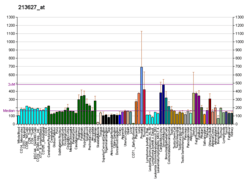MAGED2
| MAGED2 |
|---|
|
| Identifiers |
|---|
| Aliases | MAGED2, 11B6, BCG-1, BCG1, HCA10, MAGE-D2, MAGE family member D2, BARTS5 |
|---|
| External IDs | MGI: 1933391 HomoloGene: 12750 GeneCards: MAGED2 |
|---|
| Gene location (Human) |
|---|
 | | Chr. | X chromosome (human)[1] |
|---|
| | Band | No data available | Start | 54,807,599 bp[1] |
|---|
| End | 54,816,012 bp[1] |
|---|
|
| Gene location (Mouse) |
|---|
 | | Chr. | X chromosome (mouse)[2] |
|---|
| | Band | No data available | Start | 150,806,370 bp[2] |
|---|
| End | 150,814,345 bp[2] |
|---|
|
|
|
| Orthologs |
|---|
| Species | Human | Mouse |
|---|
| Entrez | | |
|---|
| Ensembl | | |
|---|
| UniProt | | |
|---|
| RefSeq (mRNA) | | |
|---|
| RefSeq (protein) | | |
|---|
| Location (UCSC) | Chr X: 54.81 – 54.82 Mb | Chr X: 150.81 – 150.81 Mb |
|---|
| PubMed search | [3] | [4] |
|---|
| Wikidata |
|
Melanoma-associated antigen D2 is a protein that in humans is encoded by the MAGED2 gene.[5]
This gene is a member of the MAGED gene family. While the MAGEA and MAGEB genes are silent in normal tissues with the exception of testis and placenta, the MAGED genes are expressed ubiquitously. The MAGED genes are clustered on chromosome Xp11. This gene is located in Xp11.2, a hot spot for X-linked mental retardation (XLMR). Multiple alternatively spliced transcript variants have been found for this gene, however, the full length nature of some variants has not been defined.[5]
References
Further reading
- Lucas S, Brasseur F, Boon T (1999). "A new MAGE gene with ubiquitous expression does not code for known MAGE antigens recognized by T cells". Cancer Res. 59 (16): 4100–3. PMID 10463614.
- Kurt RA, Urba WJ, Schoof DD (2000). "Isolation of genes overexpressed in freshly isolated breast cancer specimens". Breast Cancer Res. Treat. 59 (1): 41–8. PMID 10752678. doi:10.1023/A:1006315919985.
- Langnaese K, Kloos DU, Wehnert M, et al. (2002). "Expression pattern and further characterization of human MAGED2 and identification of rodent orthologues". Cytogenet. Cell Genet. 94 (3–4): 233–40. PMID 11856887. doi:10.1159/000048822.
- Strausberg RL, Feingold EA, Grouse LH, et al. (2003). "Generation and initial analysis of more than 15,000 full-length human and mouse cDNA sequences". Proc. Natl. Acad. Sci. U.S.A. 99 (26): 16899–903. PMC 139241
 . PMID 12477932. doi:10.1073/pnas.242603899.
. PMID 12477932. doi:10.1073/pnas.242603899.
- Ota T, Suzuki Y, Nishikawa T, et al. (2004). "Complete sequencing and characterization of 21,243 full-length human cDNAs". Nat. Genet. 36 (1): 40–5. PMID 14702039. doi:10.1038/ng1285.
- Bertrand M, Huijbers I, Chomez P, De Backer O (2005). "Comparative expression analysis of the MAGED genes during embryogenesis and brain development". Dev. Dyn. 230 (2): 325–34. PMID 15162511. doi:10.1002/dvdy.20026.
- Beausoleil SA, Jedrychowski M, Schwartz D, et al. (2004). "Large-scale characterization of HeLa cell nuclear phosphoproteins". Proc. Natl. Acad. Sci. U.S.A. 101 (33): 12130–5. PMC 514446
 . PMID 15302935. doi:10.1073/pnas.0404720101.
. PMID 15302935. doi:10.1073/pnas.0404720101.
- Harper R, Xu C, Di P, et al. (2004). "Identification of a novel MAGE D2 antisense RNA transcript in human tissues". Biochem. Biophys. Res. Commun. 324 (1): 199–204. PMID 15465002. doi:10.1016/j.bbrc.2004.09.037.
- Gerhard DS, Wagner L, Feingold EA, et al. (2004). "The Status, Quality, and Expansion of the NIH Full-Length cDNA Project: The Mammalian Gene Collection (MGC)". Genome Res. 14 (10B): 2121–7. PMC 528928
 . PMID 15489334. doi:10.1101/gr.2596504.
. PMID 15489334. doi:10.1101/gr.2596504.
- Ross MT, Grafham DV, Coffey AJ, et al. (2005). "The DNA sequence of the human X chromosome". Nature. 434 (7031): 325–37. PMC 2665286
 . PMID 15772651. doi:10.1038/nature03440.
. PMID 15772651. doi:10.1038/nature03440.
- Olsen JV, Blagoev B, Gnad F, et al. (2006). "Global, in vivo, and site-specific phosphorylation dynamics in signaling networks". Cell. 127 (3): 635–48. PMID 17081983. doi:10.1016/j.cell.2006.09.026.
- Papageorgio C, Brachmann R, Zeng J, et al. (2007). "MAGED2: a novel p53-dissociator". Int. J. Oncol. 31 (5): 1205–11. PMID 17912449. doi:10.3892/ijo.31.5.1205.
 . PMID 12477932. doi:10.1073/pnas.242603899.
. PMID 12477932. doi:10.1073/pnas.242603899. . PMID 15302935. doi:10.1073/pnas.0404720101.
. PMID 15302935. doi:10.1073/pnas.0404720101. . PMID 15489334. doi:10.1101/gr.2596504.
. PMID 15489334. doi:10.1101/gr.2596504. . PMID 15772651. doi:10.1038/nature03440.
. PMID 15772651. doi:10.1038/nature03440.




